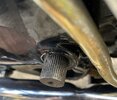Hi again,
Andy in Lincolnshire (UK here). So, in a stunning sequel to my other newbie question today, while attempting to learn the correct starting procedure for my newly-acquired 1950 Black Shadow today (holding the decompressor in 'til the bottom of the kick) I managed to strip the kickstart splines. Looking at the shaft, I think it was already in a pretty sad state when I got the bike (pic below). So I guess I need to get myself a new kickstart shaft and lever. Before I do this I wondered:
1. Is it okay just to drill and bolt the lever and shaft? Is this a thing?
2. Is there anything I can do to prevent the same happening to the new hardware? The splines look pretty fine/thin to me.
3. Is there some sort of upgrade/improvement I can do?
4. Does anyone have a link to a good resource to help me change the shaft?
I'm still feeling a bit sad and forlorn about the broken starter assembly, so I'd better fix it pronto to redeem myself!
thanks and best wishes to all,
Andy
Andy in Lincolnshire (UK here). So, in a stunning sequel to my other newbie question today, while attempting to learn the correct starting procedure for my newly-acquired 1950 Black Shadow today (holding the decompressor in 'til the bottom of the kick) I managed to strip the kickstart splines. Looking at the shaft, I think it was already in a pretty sad state when I got the bike (pic below). So I guess I need to get myself a new kickstart shaft and lever. Before I do this I wondered:
1. Is it okay just to drill and bolt the lever and shaft? Is this a thing?
2. Is there anything I can do to prevent the same happening to the new hardware? The splines look pretty fine/thin to me.
3. Is there some sort of upgrade/improvement I can do?
4. Does anyone have a link to a good resource to help me change the shaft?
I'm still feeling a bit sad and forlorn about the broken starter assembly, so I'd better fix it pronto to redeem myself!
thanks and best wishes to all,
Andy

